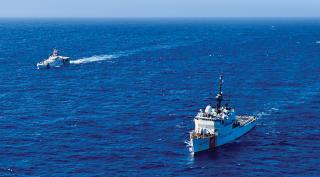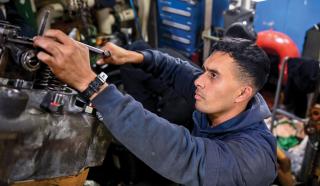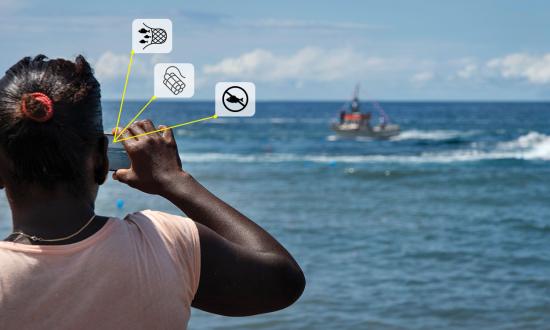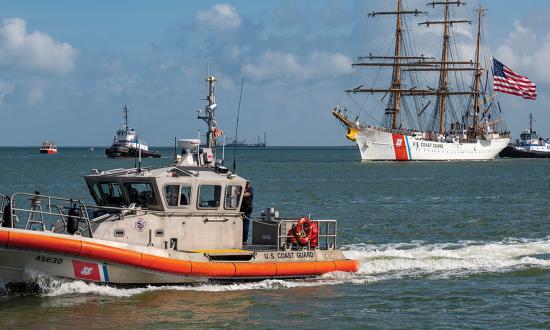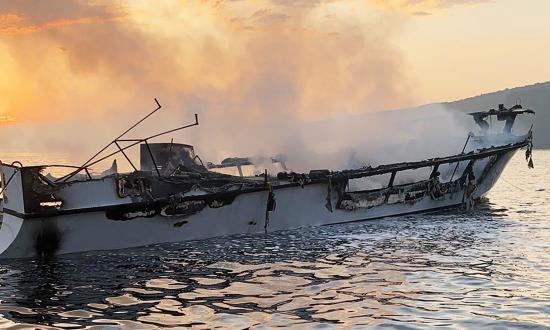In the 2011 science fiction novel (and 2015 movie) The Martian, astronaut Mark Watney finds himself in an extraplanetary pickle. Marooned on Mars with no possibility of help arriving before his supplies run out, his survival hinges on his ability to fabricate complex life-support and communication systems with the limited equipment he has on hand. In true can-do spirit, he calmly assesses the situation and proceeds to, in his words, “science the s***” out of the problem. Meanwhile, back on Earth, a team of engineers and astrophysicists scrambles to pull off a miraculous feat of ingenuity to get him assistance in time.
Cutter crews deployed far from the U.S. support infrastructure routinely face Martian-like scenarios. Vital equipment breaks, the technical support and/or parts needed to repair the cutter are thousands of miles away, and the only way to get them delivered—if at all—is through a combination of commercial and government conveyances that can take days or weeks. In the meantime, the crew either has to figure out a way to devise a makeshift repair, continue operating in a degraded status, or proceed to the nearest port, depending on the casualty’s severity. If the needed part or assistance cannot be delivered to a foreign port, the cutter has no alternative but to head back stateside, leaving a critical gap in the operational force.
Like the Navy, the Coast Guard has mission commitments that span the globe. Its newest cutter classes deliver greatly improved capability, which should translate to a commensurate leap in the Coast Guard’s ability to fulfill overseas missions. But, unlike the Navy, the Coast Guard lacks the robust network of overseas bases and fleet of auxiliary ships to support forward-deployed forces. Cutters also tend to operate independently rather than in groups, and so often they must rely solely on what is on board when something goes wrong. For the Coast Guard to fulfill the increasing demand for presence around the world and fully realize the potential of its modernized fleet, the current expeditionary logistics model needs to evolve. Cutters must be better equipped to sustain themselves while deployed, and they need more efficient means of in-theater logistics support to contend with the myriad challenges that otherwise will inhibit their operational readiness.
With Great Responsibility Comes Great Logistics Requirements
From its modest start as “a few armed vessels judiciously stationed at the entrances of our ports,” the Coast Guard has evolved into a multilayered “trident of forces” with a global range of maritime security, law enforcement, and humanitarian assistance missions. The major cutter fleet is the outermost layer and is frequently deployed far from U.S. waters.
To appreciate the present scope of cutter operations, consider some recent operational highlights. From 2020 to the present, most of the major cutter fleet has deployed from the Atlantic and Pacific coasts to patrol the main narcotrafficking corridors off South and Central America. National security cutters (NSCs) also plied the Bering, Mediterranean, and Black Seas, as well as Oceania and the western Pacific (including two highly publicized transits through the Taiwan Strait), and confronted a Chinese illegal, unreported, and unregulated (IUU) fishing fleet clustered near the Galapagos Islands. The USCGC Healy (WAGB-20) circumnavigated North America. The USCGC Polar Star (WAGB-10) ventured to the Arctic and Antarctic. Newly commissioned fast-response cutters (FRCs) sailed halfway around the world en route to their new homeport in Bahrain. The USCGC Thetis (WMEC-910) crossed the Atlantic and conducted security assistance with West African partner nations. Meanwhile, behind the headlines and the operational statistics, there was a Herculean effort to support those cutters, primarily from U.S.-based logistics hubs.
Demand for Coast Guard expeditionary presence is growing. Various strategy documents illustrate the “why,” notably the 2022 Indo-Pacific Strategy of the United States, the triservice maritime strategy Advantage at Sea, and Coast Guard strategies for the Western Hemisphere, Arctic, IUU fishing, and security sector assistance. Less well articulated is the “how.” New cutters are larger, more complex, and have greater endurance than their predecessors, but they also increase the demand on the cutter support enterprise. Meanwhile, the Coast Guard is still at least a decade away from decommissioning many legacy medium-endurance cutters and those accomplished but aged workhorses have to continue holding the line until their replacements arrive.
Experience at sea reinforces the adage “amateurs talk tactics, professionals study logistics.” At present, there are two major sources of friction in the cutter logistics apparatus: First, cutters are not configured to be adequately self-sustaining for prolonged deployments. Second, the current supply chain is not effective for supporting forward-deployed cutters when casualties exceed a ship’s force’s ability to repair them. Addressing the problem requires a closer look at both.
Challenges to Self-Sustainability
System obsolescence. Remember the Zune, Microsoft’s rival to the Apple iPod in the early days of the MP3 player revolution? If not, that is because the platform never really caught on. But imagine your vehicle’s navigation and control system runs on a Zune and you have to replace it to keep the vehicle running. Zunes have long since disappeared from shelves, and no one supports them anymore. Maybe you can find one in a pawn shop or pull one out of another car like yours, but otherwise you are out of luck.
Cutters find themselves in that quandary all too frequently. Many systems installed over time are obsolete, which means there is no readily available replacement or repair option when they fail. In an interview with Business Insider, the commanding officer of the Polar Star confided that eBay is the only source of some critical parts needed to keep the United States’ only heavy icebreaker operational, and there will be no recourse for further repairs once those are gone.1 The alternative to placing cutters in that position is an active effort to identify systems nearing or beyond obsolescence and replace them with updated components that are available and supportable. That, of course, costs money and competes with funding for other priorities, such as new cutter acquisition.
Few and exquisite systems. On the opposite end of the obsolescence spectrum, a common problem encountered especially in new cutters is difficulty in keeping modern, highly technical systems operational. The integrated C5ISR, navigation, and engineering systems that enable the next-generation capabilities for those platforms are fantastic when they work as designed but difficult to repair when they fail. Shipboard technicians are not equipped to troubleshoot certain equipment beyond a basic level, and many new systems include proprietary software that requires factory-certified contractors to diagnosis and repair. In some cases, there is a single person with the requisite permissions and qualifications contracted to maintain a system for an entire cutter class.
Lack of redundancy. A maxim applicable to both skydiving and patrol planning is “two is one, one is none.” The most dramatic example of that principle in the cutter fleet is the Polar-class icebreakers, for which one is decommissioned and serving as a parts donor for the other. The probability that one of the many critical systems on board a cutter will fail during a long deployment is high, which underscores the necessity of having a backup. At present, some systems considered essential to operate cutters safely have no backup. A casualty to those systems creates a single point of failure, which can result in the cutter no longer being able to perform its mission. Even the most advanced cutters, the Legend-class NSCs, deal with this challenge. Often they end up having to conduct controlled parts exchanges (taking working parts from one cutter and installing them in another) to deploy on schedule and/or remain underway.
Challenges to In-theater Logistics
Overextended supply lines. Supply lines for getting critical parts to cutters in forward areas are long and cumbersome, involving multiple sorties and complex interagency coordination that results in several days to weeks between need and delivery. For example, a typical parts request for a cutter in the eastern Pacific requires shipping from a warehouse in Maryland to a hub in Florida, from there to one or more forward airfields, where it is eventually loaded onto a military aircraft and dropped via parachute to the cutter. Only certain parts can be delivered by that method; others are too large or delicate. For those, cutters have to make do until they return stateside.
Technical support. Shipboard engineers and technicians can troubleshoot many systems only to a certain point, beyond which complexity and/or proprietary limitations require outside technical assistance. Yet contracted technicians are a high-demand/low-density resource, often requested by multiple units in widely separated areas. Worse, some technical support contracts limit travel availability to within the continental United States, depriving that resource to deployed cutters experiencing a casualty to that system.
Sustainment. Major cutters have the endurance to remain underway for weeks, but providing an option to fuel and replenish at sea (FAS/RAS) enhances their efficiency by reducing the number of days they must go off station to receive those services in port. During a counterdrug surge operation in 2020, for example, a USNS oiler provided FAS/RAS support to Coast Guard and Navy ships operating in the eastern Pacific, resulting in a significantly improved smuggling vector coverage. The value of that capability would have an even more profound impact on FRCs, which have to refuel and reprovision far more often, resulting in a high percentage of deployment days spent transiting to/from logistics port calls.
Options to Improve Expeditionary Cutter Support
The next great leap in cutter capability is not a platform, it is a logistics enterprise configured to better support expeditionary operations. The Navy already has the best naval logistics system in the world, which the Coast Guard should seek to further integrate with and emulate to the extent practical. Examples and precedents hint at a way forward, but at present there is no connecting vision to put it all together. Following are some proven concepts that should be pursued to better meet cutter needs:
Improved cutter self-sustainability. Every vital system on a cutter should be scrutinized through a three-question lens: Is there a backup if this fails? Does ship’s force have the ability to repair it underway? Are parts available to fix or replace it? Any systems that do not meet those criteria represent a liability to the cutter’s expeditionary readiness and should be replaced with ones that do. For systems that require external technical support, the terms of the support contract must provide for short-notice deployment to anywhere the cutter may be operating.
Forward operating bases. A forward operating base (FOB) in Central America would be an instant game-changer in a high-priority region with the largest concentration of deployed major cutters. It need not be elaborate to be effective—a warehouse to stage commonly needed parts (and, ideally, spare cutter boats), technical support and force protection personnel, and a medical facility with a flight surgeon or physician assistant who can provide higher-level care (the latter would alleviate the need for medical evacuations from foreign countries, which are difficult to coordinate and sometimes near-impossible because of COVID-19 restrictions). Nice-to-haves would include a fuel depot, T100 internet connection, and recreational facilities to provide off-ship leisure for crews—even more important now as COVID-19 continues to limit foreign port liberty options.
Ideally, the Coast Guard could obtain FOBs on both the Caribbean and Pacific sides of Central America. A Caribbean FOB would be optimal for supporting FRCs, which have some major cutter capabilities but lack the endurance and self-sustainability for prolonged unsupported deployments. The Pacific side also could support FRCs but primarily would serve the major cutter fleet where it is most in need of support.
Funding aside, the largest roadblock to implementing the FOB vision is political. The United States has a complicated relationship with Latin America; however, there has never been a more vital time to start improving that relationship. It is no secret that China is heavily courting Latin America and attempting to expand its influence in the region. This has already begun to impact Coast Guard operations. Chinese pressure likely was behind Argentina’s reluctance to cooperate with or provide port services for the USCGC Stone (WMSL-758) during a recent South American IUU fishing patrol.2 If one or more FOB locations could be coordinated in conjunction with other incentives in the host nation’s interests, the resulting arrangement would yield strategic value far beyond just providing cutter support. Indeed, the Coast Guard is the ideal service to stage out of regions sensitive to U.S. military presence because of its primarily law enforcement and humanitarian purposes.
Mission support cutter. Another need is dedicated support ships, similar to the USNS fleet that augments global Navy operations. A “mission support cutter” could be as basic as a converted offshore supply vessel loaded with extra parts, technical assistance, and a medical bay. Investing in a more capable platform could add other valuable services such as the ability to refuel and reprovision cutters at sea and operate unmanned aerial systems for maritime surveillance, facilities to more comfortably hold detainees awaiting transport ashore, and even additive manufacturing capability to produce hard-to-obtain parts on demand (a concept submarines and some Navy ships already employ).3 Various support vessel prototypes have been fielded in limited capacities in the past, but none have delivered the level of support required to make a significant impact on cutter sustainment.
Worth the Investment
Cutter support personnel perform incredible feats of coordination to get parts and assistance to far-flung places; the complexity of the process reveals that a better expeditionary logistics model is sorely needed. “Mission to Mars” is hyperbole, but from the operator perspective, it sometimes feels like the support needed to keep cutters capable must come from another planet. Cuttermen are an ingenious lot. They can “science the s***” out of complex challenges with the best of them. Combine that ingenuity with more efficient forward logistics support and the operational return on investment will be astronomical.
1. Christopher Woody, “The Heavy-Duty Ship the U.S. Needs to Protect Its Thawing Border with Russia ‘Is Just Falling Apart,’ Captain Says,” Business Insider, 10 March 2021.
2. Ralph Espach, “A New Great Game Finds the South Atlantic,” War on the Rocks, 22 March 2021.
3. Megan Eckstein, “Navy Looks to 3D Printing for Submarine Parts to Ease Burden on Strained Industrial Base,” Defense News, 4 February 2022.




